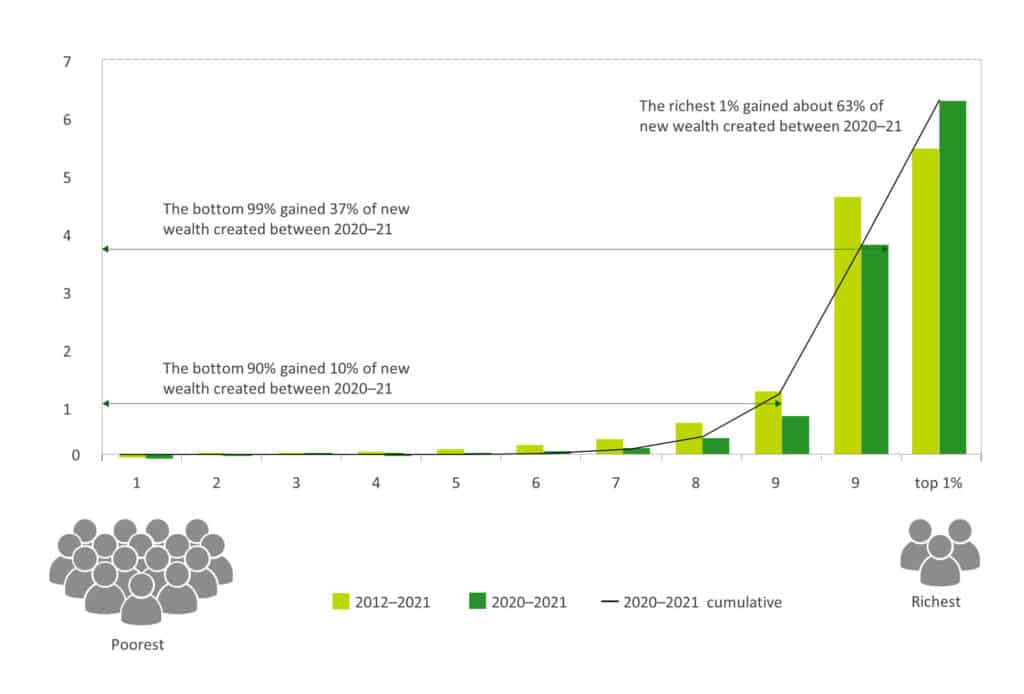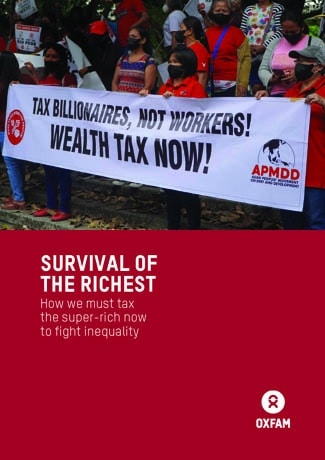
Source: Oxfam calculation based on Credit Suisse Global Wealth Report
The richest 1 percent grabbed nearly two-thirds of all new wealth worth $42 trillion created since 2020, almost twice as much money as the bottom 99 percent of the world’s population, reveals a new Oxfam report today. During the past decade, the richest 1 percent had captured around half of all new wealth.

Gabriela Bucher, Executive Director of Oxfam International says: “It’s time we demolish the convenient myth that tax cuts for the richest result in their wealth somehow ‘trickling down’ to everyone else. Forty years of tax cuts for the super-rich have shown that a rising tide doesn’t lift all ships — just the superyachts.”
Billionaires have seen extraordinary increases in their wealth. During the pandemic and cost-of-living crisis years since 2020, $26 trillion (63 percent) of all new wealth was captured by the richest 1 percent, while $16 trillion (37 percent) went to the rest of the world put together. A billionaire gained roughly $1.7 million for every $1 of new global wealth earned by a person in the bottom 90 percent. Billionaire fortunes have increased by $2.7 billion a day. This comes on top of a decade of historic gains —the number and wealth of billionaires having doubled over the last ten years.
Billionaire wealth surged in 2022 with rapidly rising food and energy profits. The report shows that 95 food and energy corporations have more than doubled their profits in 2022. They made $306 billion in windfall profits, and paid out $257 billion (84 percent) of that to rich shareholders. The Walton dynasty, which owns half of Walmart, received $8.5 billion over the last year. Indian billionaire Gautam Adani, owner of major energy corporations, has seen this wealth soar by $42 billion (46 percent) in 2022 alone. Excess corporate profits have driven at least half of inflation in Australia, the US and the UK.
At the same time, at least 1.7 billion workers now live in countries where inflation is outpacing wages, and over 820 million people — roughly one in ten people on Earth — are going hungry. Women and girls often eat least and last, and make up nearly 60 percent of the world’s hungry population. The World Bank says we are likely seeing the biggest increase in global inequality and poverty since WW2. Entire countries are facing bankruptcy, with the poorest countries now spending four times more repaying debts to rich creditors than on healthcare. Three-quarters of the world’s governments are planning austerity-driven public sector spending cuts —including on healthcare and education— by $7.8 trillion over the next five years.
Oxfam is calling for a systemic and wide-ranging increase in taxation of the super-rich to claw back crisis gains driven by public money and profiteering. Decades of tax cuts for the richest and corporations have fueled inequality, with the poorest people in many countries paying higher tax rates than billionaires.
Elon Musk, one of the world’s richest men, paid a “true tax rate” of about 3 percent between 2014 and 2018. Aber Christine, a flour vendor in Uganda, makes $80 a month and pays a tax rate of 40 percent.
Worldwide, only four cents in every tax dollar now comes from taxes on wealth. Half of the world’s billionaires live in countries with no inheritance tax for direct descendants. They will pass on a $5 trillion tax-free treasure chest to their heirs, more than the GDP of Africa, which will drive a future generation of aristocratic elites. Rich people’s income is mostly unearned, derived from returns on their assets, yet it is taxed on average at 18 percent, just over half as much as the average top tax rate on wages and salaries.
The report shows that taxes on the wealthiest used to be much higher. Over the last forty years, governments across Africa, Asia, Europe, and the Americas have slashed the income tax rates on the richest. At the same time, they have upped taxes on goods and services, which fall disproportionately on the poorest people and exacerbate gender inequality. In the years after WW2, the top US federal income tax rate remained above 90 percent and averaged 81 percent between 1944 and 1981. Similar levels of tax in other rich countries existed during some of the most successful years of their economic development and played a key role in expanding access to public services like education and healthcare.
According to new analysis by the Fight Inequality Alliance, Institute for Policy Studies, Oxfam and the Patriotic Millionaires, an annual wealth tax of up to 5 percent on the world’s multi-millionaires and billionaires could raise $1.7 trillion a year, enough to lift 2 billion people out of poverty, fully fund the shortfalls on existing humanitarian appeals, deliver a 10-year plan to end hunger, support poorer countries being ravaged by climate impacts, and deliver universal healthcare and social protection for everyone living in low- and lower middle-income countries.


